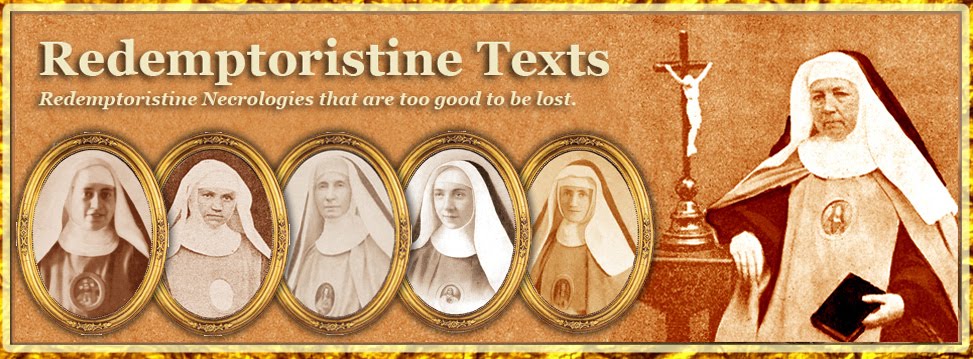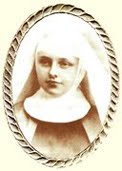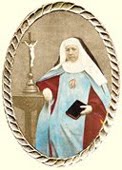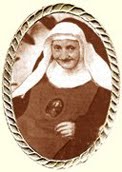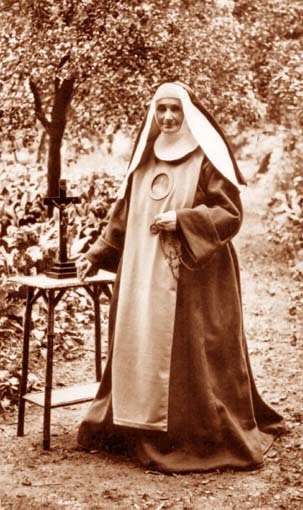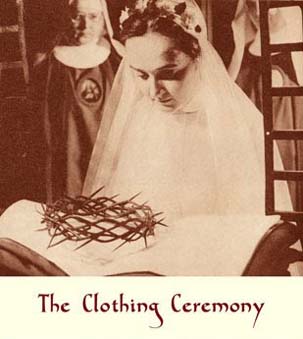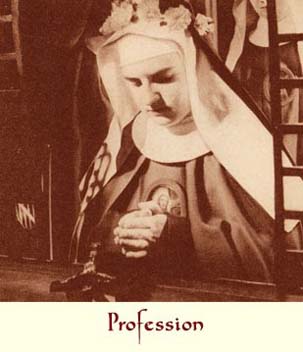Born Eleonore Donat
Mother Marie-Aloysia was born on 4th September 1822 at Georgswald in Bohemia of parents favoured by property and fortune, but esteemed especially because of their virtues. Her father had so lively a faith that one day he was cured miraculously of a dangerous illness by the single invocation of the name of Jesus.
Young Eleonore had a very lively and outgoing spirit, which attracted many reprimands to her from the part of her mother, whose character was rather inclined to severity. After two years in boarding school spent with the Cistercian Sisters of Marienstern in Saxony, she lived piously in the paternal home, until the marriage of her sister caused her attention to become fixed upon the choice of a state of life. She prayed a great deal to the Holy Spirit and the Blessed Virgin, and spent long hours in the chapel of the Capuchins of Rumburg. Finally, after about eighteen days of prayer and reflection, she woke up one morning quite decided to preserve her virginity. “I dreamed during the night,” she said, “that I entered our parish church to ask for God’s light there. But then on the threshold I saw two great open letters. One of them had written in beautiful characters: “Do not marry!” and on the other: “But rather become an anchorite.” So I do not wish to have an earthly husband,” she added.
Soon afterwards she decided for the religious life, but in a convent where the primitive Rule was still in vigour. This resolution was strengthened by reading the beautiful work of St. Alphonsus called “The true Spouse of Jesus Christ.” Then once more on the occasion of the marriage of another of her sisters, for the first time in her life she heard mention of the name of the “Redemptoristine Sisters,” in reference to an incident that a newspaper in Vienna reported about them. “There is where I must go,” she said resolutely, and soon she had more complete information about the Order that finally decided her vocation. Her father accompanied her to Vienna and put her into the hands of the Superior, saying: “I am bringing you my child, who has never caused me any pain.” This was on 10th October 1846. Eleonore’s extreme love for her father was the great temptation for her at the beginning of her religious life. She emerged victorious from it and received the habit on 16th November 1847, with the name of Sister Marie-Aloysia of the Blessed Sacrament. On the same day, the Venerable Father Joseph Passerat, the Vicar-General of the Redemptorists, came to visit the convent and when he saw Sister Marie-Aloysia, he said: “She who is now the last will one day be the first in the community.” It was prophetic.
* * * *
Five months of her novitiate passed under the wise conduct of Mother Marie-Victoria, born the Countess of Welsersheimb, one of the first Redemptoristines beyond the Alps. In the month of April 1848, the Revolution broke out and obliged the Sisters to abandon their holy retreat at night. It was in this grave conjuncture that the novice, Marie-Aloysia gave proof of her solid virtue. Disguised in secular clothes, she first of all found refuge with the sister of her Mistress Marie-Victoria, Madam the Baroness of Lago. Fear of being discovered, made more real by the continual pursuits carried out against “the Liguorians” was the reason why she went to stay with a friend of her father, until he brought her to her paternal home. Amongst all these vicissitudes, Sister Marie-Aloysia, in spite of her profound sadness, maintained an admirable calmness and meekness. In the domestic home, she put the Redemptoristine habit back on and continued her life as a novice in the best way possible, without refusing to do manual jobs around the house. She then devoted herself especially to the illness of her youngest sister Marie, who died at the age of fifteen. For eighteen weeks she lavished upon her night and day the care that her state required.
In order to receive Holy Communion more often, she did not hesitate to often make a long journey, in the early morning, through the snow and darkness, and went to the Capuchin church in Rumburg, where they were less miserly than elsewhere in the distribution of this sacred bread. However, she longed for her little cell “which was,” she said, “so near to Jesus in the Blessed Sacrament.” Her wishes were finally heard. Following the circumstances already known to the reader, the Redemptoristine Monastery of Marienthal had just been inaugurated on 26th June 1851, on the feast of the Sacred Heart of Jesus. As soon as she learnt of this happy event, Sister Marie-Aloysia hastened to tear herself away from the love of her relatives and went there, brought once more by her father, and took refuge in the new asylum. On 22nd April 1852, she was united forever to her divine Redeemer by the vows of religion.
So we can see how her trial only succeeded in increasing her fervour. Her love for observance and the interior life, and her devotion to the sacred mysteries, shone out with even greater brilliance, at the same time that her zeal for the Divine Office and her abilities at the different tasks in the monastery. For many years she was Mistress of Educandes and then Mistress of Novices. In the exercise of these two charges, she demonstrated a truly maternal goodness to her daughters, but yet using a holy rigour in forming them in solid virtues and the observance of the Rules. She instructed them besides more by her examples than her words, and thus was able to gain the affection and confidence of them all. “She was an accomplished religious” said a contemporary. In 1868 she was chosen to replace the Reverend Mother Marie-Gabrielle in the charge of Superior. And it was then that she had a little chapel erected in honour of Our Lady of Perpetual Succour, whose cult was beginning to be propagated. She also renovated the mortuary chapel of the convent. When her triennium had expired she was elected Vicar and distinguished herself then as much by her love for the hidden life as she had done by her great qualities of zealous Superior.
* * * * *
Who would have thought that Mother Marie-Aloysia had once again to leave her dear convent? However, this happened in 1871. The Convent of Vienna had just lost its Superior, Mother Marie-Madeleine, who as she lay dying, advised asking for the Mother Vicar of Marienthal to succeed her. After long hesitations, Marienthal finally decided to make the sacrifice demanded of them. Mother Marie-Aloysia submitted herself humbly to the will of God. Accompanied by the Very Rev. Father Heilig, the Superior of the German Redemptorists, she left for Cologne. Her spirit of recollection and sacrifice made her renounce seeing the magnificent cathedral in this city and the beautiful countryside along the Rhine. In Vienna, she was received with a jubilation that contrasted singularly with the painful trials that were about to be her lot.
In fact, the Monastery was in such a deplorable state in matters material and financial that they feared they would have to abandon it. Soon the good Mother was seized by a throat infection so painful that it made her unfit for service in the choir, already depleted by the small number of her subjects and the bad health of others. She recovered from this illness after ten months, through the intercession of Saint Joseph, to whom she vowed a special cult. To remedy the lack of vocations, she solemnly consecrated the community, and particularly the educandate, to the Sacred Heart of Jesus. Heaven’s first response was a new illness that nailed the Superior onto a bed of sorrows for the space of fifteen months, while three other Sisters also fell very dangerously ill.
In these terrible trials, the Superior showed a profound humility, a perfect resignation to the will of God, and a confidence truly magnanimous in His mercy. In spite of obstacles that appeared to be insurmountable, they maintained the service of the choir as well as they could. This faithfulness was rewarded in a touching manner. All the Sisters attested that on Sundays especially and on feast days, an unknown voice resonated with theirs in the chant for Terce and Vespers, and the miracle lasted until the number of religious was increased. This was like a signal of deliverance. The worthy Superior and her courageous daughters sought their support in prayer. They held processions and introduced a Holy Hour in honour of the Sacred Heart of Jesus. These prayers were heard. Mother recovered against all hope, vocations multiplied, and benefactors opened their hearts and hands to meet the needs of the Monastery.
Mother Marie-Aloysia held the position of Superior from 1871 to 1877. Then, after three years as Vicar, she was re-elected Superior and remained so until her blessed death, which arrived in 1889. It was her religious virtues, whose example she gave constantly, that caused her to be so long the head of her Sisters. They admired her love of poverty, and that spirit of perfect obedience which made her say one day to a religious: “My Sister, we must not permit ourselves even thoughts contrary to those of the Superior, as these thoughts will make us lose the merit of obedience.”
Her recollection was continuous, and she practised it everywhere, even in the garden, where the modesty of her eyes was admirable. So she was so filled with the spirit of God that a special grace accompanied her words. One day, a visiting priest had her called to the parlour and asked her for a word of consolation and encouragement. Mother Marie-Aloysia was astonished and replied timidly: “My Reverend Father, God is so good! Yes, He is extremely good!” The priest replied: “This is enough for me, my Reverend Mother”, and he left completely consoled.
As Superior, she always demonstrated a very maternal goodness and solicitude to her daughters. The sick especially were the object of her scrupulous attention. Even though she was ill herself and overloaded with occupations, she visited them often.
After the Immaculate Virgin and Saint Joseph, she especially honoured Saint Alphonsus. The spiritual works of the holy Doctor were her preferred books, and she frequently recommended reading them to her daughters. Finally, the souls in Purgatory found in her a tender and devoted friend.
Such were the principal features of the life and virtues of the good Mother Marie-Aloysia. During her last years, the heavenly Spouse announced His approach several times by illnesses and infirmities. On 8th September, on the feast of the Nativity of the Blessed Virgin, she took Holy Communion in choir with her Sisters for the last time. Soon afterwards, she had to go to bed and receive the last sacraments. Finally, on the night of 20th September 1889, she went to sleep peacefully in the Lord, at the age of 67 and 16 days, in the 36th year of her religious profession.
Young Eleonore had a very lively and outgoing spirit, which attracted many reprimands to her from the part of her mother, whose character was rather inclined to severity. After two years in boarding school spent with the Cistercian Sisters of Marienstern in Saxony, she lived piously in the paternal home, until the marriage of her sister caused her attention to become fixed upon the choice of a state of life. She prayed a great deal to the Holy Spirit and the Blessed Virgin, and spent long hours in the chapel of the Capuchins of Rumburg. Finally, after about eighteen days of prayer and reflection, she woke up one morning quite decided to preserve her virginity. “I dreamed during the night,” she said, “that I entered our parish church to ask for God’s light there. But then on the threshold I saw two great open letters. One of them had written in beautiful characters: “Do not marry!” and on the other: “But rather become an anchorite.” So I do not wish to have an earthly husband,” she added.
Soon afterwards she decided for the religious life, but in a convent where the primitive Rule was still in vigour. This resolution was strengthened by reading the beautiful work of St. Alphonsus called “The true Spouse of Jesus Christ.” Then once more on the occasion of the marriage of another of her sisters, for the first time in her life she heard mention of the name of the “Redemptoristine Sisters,” in reference to an incident that a newspaper in Vienna reported about them. “There is where I must go,” she said resolutely, and soon she had more complete information about the Order that finally decided her vocation. Her father accompanied her to Vienna and put her into the hands of the Superior, saying: “I am bringing you my child, who has never caused me any pain.” This was on 10th October 1846. Eleonore’s extreme love for her father was the great temptation for her at the beginning of her religious life. She emerged victorious from it and received the habit on 16th November 1847, with the name of Sister Marie-Aloysia of the Blessed Sacrament. On the same day, the Venerable Father Joseph Passerat, the Vicar-General of the Redemptorists, came to visit the convent and when he saw Sister Marie-Aloysia, he said: “She who is now the last will one day be the first in the community.” It was prophetic.
* * * *
Five months of her novitiate passed under the wise conduct of Mother Marie-Victoria, born the Countess of Welsersheimb, one of the first Redemptoristines beyond the Alps. In the month of April 1848, the Revolution broke out and obliged the Sisters to abandon their holy retreat at night. It was in this grave conjuncture that the novice, Marie-Aloysia gave proof of her solid virtue. Disguised in secular clothes, she first of all found refuge with the sister of her Mistress Marie-Victoria, Madam the Baroness of Lago. Fear of being discovered, made more real by the continual pursuits carried out against “the Liguorians” was the reason why she went to stay with a friend of her father, until he brought her to her paternal home. Amongst all these vicissitudes, Sister Marie-Aloysia, in spite of her profound sadness, maintained an admirable calmness and meekness. In the domestic home, she put the Redemptoristine habit back on and continued her life as a novice in the best way possible, without refusing to do manual jobs around the house. She then devoted herself especially to the illness of her youngest sister Marie, who died at the age of fifteen. For eighteen weeks she lavished upon her night and day the care that her state required.
In order to receive Holy Communion more often, she did not hesitate to often make a long journey, in the early morning, through the snow and darkness, and went to the Capuchin church in Rumburg, where they were less miserly than elsewhere in the distribution of this sacred bread. However, she longed for her little cell “which was,” she said, “so near to Jesus in the Blessed Sacrament.” Her wishes were finally heard. Following the circumstances already known to the reader, the Redemptoristine Monastery of Marienthal had just been inaugurated on 26th June 1851, on the feast of the Sacred Heart of Jesus. As soon as she learnt of this happy event, Sister Marie-Aloysia hastened to tear herself away from the love of her relatives and went there, brought once more by her father, and took refuge in the new asylum. On 22nd April 1852, she was united forever to her divine Redeemer by the vows of religion.
So we can see how her trial only succeeded in increasing her fervour. Her love for observance and the interior life, and her devotion to the sacred mysteries, shone out with even greater brilliance, at the same time that her zeal for the Divine Office and her abilities at the different tasks in the monastery. For many years she was Mistress of Educandes and then Mistress of Novices. In the exercise of these two charges, she demonstrated a truly maternal goodness to her daughters, but yet using a holy rigour in forming them in solid virtues and the observance of the Rules. She instructed them besides more by her examples than her words, and thus was able to gain the affection and confidence of them all. “She was an accomplished religious” said a contemporary. In 1868 she was chosen to replace the Reverend Mother Marie-Gabrielle in the charge of Superior. And it was then that she had a little chapel erected in honour of Our Lady of Perpetual Succour, whose cult was beginning to be propagated. She also renovated the mortuary chapel of the convent. When her triennium had expired she was elected Vicar and distinguished herself then as much by her love for the hidden life as she had done by her great qualities of zealous Superior.
* * * * *
Who would have thought that Mother Marie-Aloysia had once again to leave her dear convent? However, this happened in 1871. The Convent of Vienna had just lost its Superior, Mother Marie-Madeleine, who as she lay dying, advised asking for the Mother Vicar of Marienthal to succeed her. After long hesitations, Marienthal finally decided to make the sacrifice demanded of them. Mother Marie-Aloysia submitted herself humbly to the will of God. Accompanied by the Very Rev. Father Heilig, the Superior of the German Redemptorists, she left for Cologne. Her spirit of recollection and sacrifice made her renounce seeing the magnificent cathedral in this city and the beautiful countryside along the Rhine. In Vienna, she was received with a jubilation that contrasted singularly with the painful trials that were about to be her lot.
In fact, the Monastery was in such a deplorable state in matters material and financial that they feared they would have to abandon it. Soon the good Mother was seized by a throat infection so painful that it made her unfit for service in the choir, already depleted by the small number of her subjects and the bad health of others. She recovered from this illness after ten months, through the intercession of Saint Joseph, to whom she vowed a special cult. To remedy the lack of vocations, she solemnly consecrated the community, and particularly the educandate, to the Sacred Heart of Jesus. Heaven’s first response was a new illness that nailed the Superior onto a bed of sorrows for the space of fifteen months, while three other Sisters also fell very dangerously ill.
In these terrible trials, the Superior showed a profound humility, a perfect resignation to the will of God, and a confidence truly magnanimous in His mercy. In spite of obstacles that appeared to be insurmountable, they maintained the service of the choir as well as they could. This faithfulness was rewarded in a touching manner. All the Sisters attested that on Sundays especially and on feast days, an unknown voice resonated with theirs in the chant for Terce and Vespers, and the miracle lasted until the number of religious was increased. This was like a signal of deliverance. The worthy Superior and her courageous daughters sought their support in prayer. They held processions and introduced a Holy Hour in honour of the Sacred Heart of Jesus. These prayers were heard. Mother recovered against all hope, vocations multiplied, and benefactors opened their hearts and hands to meet the needs of the Monastery.
Mother Marie-Aloysia held the position of Superior from 1871 to 1877. Then, after three years as Vicar, she was re-elected Superior and remained so until her blessed death, which arrived in 1889. It was her religious virtues, whose example she gave constantly, that caused her to be so long the head of her Sisters. They admired her love of poverty, and that spirit of perfect obedience which made her say one day to a religious: “My Sister, we must not permit ourselves even thoughts contrary to those of the Superior, as these thoughts will make us lose the merit of obedience.”
Her recollection was continuous, and she practised it everywhere, even in the garden, where the modesty of her eyes was admirable. So she was so filled with the spirit of God that a special grace accompanied her words. One day, a visiting priest had her called to the parlour and asked her for a word of consolation and encouragement. Mother Marie-Aloysia was astonished and replied timidly: “My Reverend Father, God is so good! Yes, He is extremely good!” The priest replied: “This is enough for me, my Reverend Mother”, and he left completely consoled.
As Superior, she always demonstrated a very maternal goodness and solicitude to her daughters. The sick especially were the object of her scrupulous attention. Even though she was ill herself and overloaded with occupations, she visited them often.
After the Immaculate Virgin and Saint Joseph, she especially honoured Saint Alphonsus. The spiritual works of the holy Doctor were her preferred books, and she frequently recommended reading them to her daughters. Finally, the souls in Purgatory found in her a tender and devoted friend.
Such were the principal features of the life and virtues of the good Mother Marie-Aloysia. During her last years, the heavenly Spouse announced His approach several times by illnesses and infirmities. On 8th September, on the feast of the Nativity of the Blessed Virgin, she took Holy Communion in choir with her Sisters for the last time. Soon afterwards, she had to go to bed and receive the last sacraments. Finally, on the night of 20th September 1889, she went to sleep peacefully in the Lord, at the age of 67 and 16 days, in the 36th year of her religious profession.
This necrology is translated from Fleurs de l'Institut des Rédemptoristines by Mr John R. Bradbury. The copyright of this translation is the property of the Redemptoristine Nuns of Maitland, Australia. The integral version of the translated book will be posted here as the necrologies appear.
